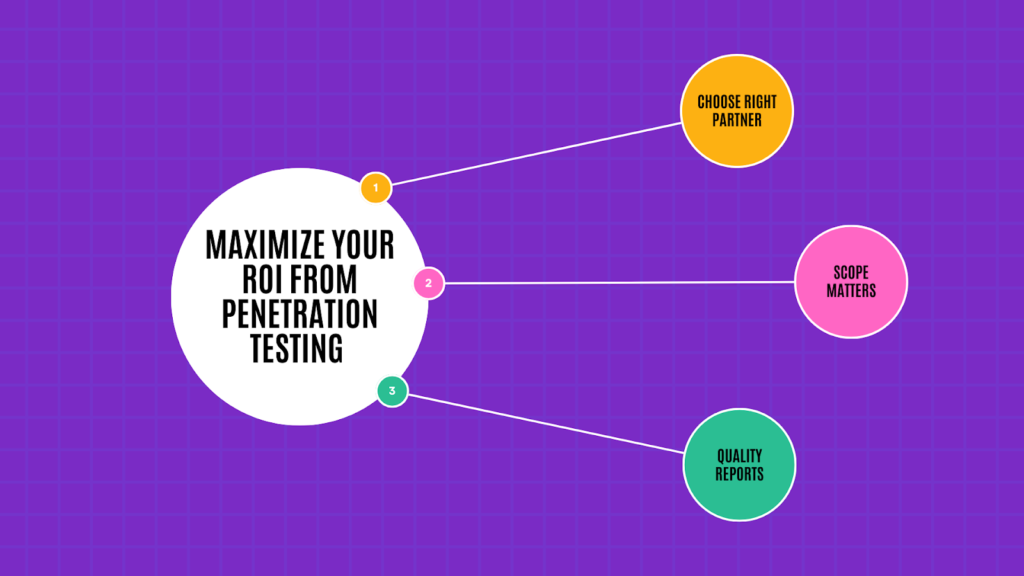Introduction:
Cybersecurity has to be a major concern for businesses in light of the growing cyber threats and increased regulatory pressure. A single breach can cost a business dearly, financially, and reputation-wise. Investing in the operation of security safeguards creates long-term trust.
Cybersecurity ROI:
ROI of cybersecurity is a form of assurance to the organization about the value derived from their investment in securities. It shows a balance between security initiatives costs and the possible savings by not allowing a breach, data loss, or downtime. A positive ROI means the measures taken for cybersecurity have reduced the risks effectively, saving them in the long run and keeping the business continuity intact.

Is penetration testing worth the investment?
This blog will show you exactly how a penetration test provides an appreciable return on investment by discovering vulnerabilities before the attackers do, reducing breach-related costs, ensuring compliance, and improving overall security.
Penetration Testing: A Non-technical Explanation
Penetration testing is like hiring someone to break into your house to find weaknesses before an intruder does. Ethical hackers test computer systems, networks, or applications to uncover security flaws, so you can fix them.
Penetration Testing: A Technical Perspective
Penetration testing simulates cyberattacks to identify vulnerabilities in systems, networks, or apps. Ethical hackers use tools and techniques to exploit weaknesses, helping organizations strengthen their security. Thus, both explanations make us realize how important penetration testing is.
- The Cost of a Cybersecurity Breach:
A cybersecurity breach has a wider impact than just the initial disruption. Being in a position to understand the true cost means the organization can prioritize its security measures against potentially devastating losses.
- Financial Impact:
A cybersecurity breach has several possible serious financial outcomes. Non-compliance with regulations concerning data protection, such as GDPR, may lead to heavy fines, possibly running into millions of dollars. The costs associated with recovery are also very high, including IT resources, forensic investigations, and legal fees. For example, a small business hit by ransomware may have to pay tens of thousands of dollars in recovery costs, plus lost revenue during downtime while systems are restored. To mitigate these risks, frameworks like ISO 27001 and SOC-2 provide strong security controls and emphasize the importance of penetration testing to identify vulnerabilities, ensuring a proactive approach to safeguarding sensitive data.
- Reputational Damage:
One of the biggest breach costs is damage to an organization’s reputation. A data breach can result in the loss of customers especially if sensitive information is mishandled or publicly exposed. According to a 2017 by Thales Group, Reference: survey by Thales Group, 70% of customers would stop doing business with a company after a data breach. This can lead to long-term customer churning and reduced revenue, therefore making reputational damage one of the costliest and longest-lasting impacts of a breach.
- Operation Downtime:
Breaches can cause severe operational disruption: when systems are compromised or taken offline, delays and inefficiencies lead to crippling business operations. For instance, a logistic company unable to access its system in the middle of a ransomware attack may be seriously delayed from delivering goods and, therefore, hurting client relations, further hurting revenue.
- Cost of a Data Breach Vs Penetration Testing Investment:
Investment in proactive cybersecurity measures, such as penetration testing, is considerably less expensive than the cost associated with data breaches. Here are some hypothetical analytics to show the cost of a data breach vs the cost of penetration testing.
The Cost of Data Breaches:
- Global Average: In 2024, the global average cost of a data breach reached $4.88 million, up 10% from the prior year and the highest total ever recorded. Reference: IBM – United States
- SMBs: For organizations with less than 500 employees, the average cost of a data breach was $3.31 million, up 13.4% compared to the previous year. Reference: UpGuard
- Large Enterprises: In the United States, the average cost of a data breach was $9.36 million in 2024, down from $9.48 million in the previous year. Reference: Statista
The Cost of Penetration Testing:
- Small Businesses: Penetration testing costs typically range from $5,000 to $10,000, depending on the scope and complexity.
- Midsize Organizations: Costs usually range from $10,000 to $30,000, influenced by factors such as the number of systems and applications tested.
- Large Enterprises: Comprehensive penetration testing can range from $30,000 to $100,000 or more, especially when multiple testing techniques and in-depth assessments are involved.
References: Penetration Testing costs
Thus, These numbers stated side by side show that investment in penetration testing is a fraction of what the financial fallouts from a data breach could be. This proactive identification and mitigation of vulnerabilities help organizations save millions in potential costs arising from a breach, thus making testing a very cost-effective way to go in creating a comprehensive cybersecurity strategy. During our penetration testing, we discovered an IDOR (Insecure Direct Object Reference) vulnerability on a subscription and payment management system. By manipulating request parameters, we were able to gain unauthorized access to and modify billing information, including sensitive details like addresses and subscription history. This vulnerability posed significant risks, as it allowed unauthorized users to not only view but also alter financial data, potentially leading to severe financial and reputational damage. This highlights the importance of penetration testing.
Penetration Testing as Proactive Security Measurement:
- Simulating real-world cyberattacks helps uncover vulnerabilities before hackers can exploit them.
- By identifying risks related to unauthorized data access or leaks, penetration testing prevents costly data breaches.
- Penetration testing checks the effectiveness of firewalls, intrusion detection systems, and security policies to ensure everything is working as it should.
- It helps organizations stay compliant with regulations like GDPR, PCI-DSS, and HIPAA by pinpointing any compliance gaps.
- With penetration testing, businesses can reduce the risk of financial loss, reputational damage, and the legal consequences that come from security breaches.
- It provides actionable insights to enhance the way an organization detects, monitors, and responds to security incidents.
- Penetration testing identifies vulnerabilities in applications, APIs, and web services before they’re deployed, helping to keep everything secure.
- It also tests how well your team understands and responds to security threats, ensuring your security awareness programs are effective.
- By offering insights for continuous improvement, penetration testing helps organizations strengthen their security posture over time.
- A strong commitment to cybersecurity not only secures your organization but also builds trust and confidence among your customers and stakeholders.
How does penetration testing work:
- Scoping & Planning:
First, we define the scope, identify critical assets, and outline the testing methodology. We use frameworks like OWASP’s Top 10 to ensure we’re covering the most common vulnerabilities.
- Reconnaissance:
Gathering OSINT, identifying exposed services, and locating potential attack vectors is the focus here.
- Scanning & Enumeration:
Automated tools help us scan for weaknesses in the system and app, quickly identifying vulnerabilities like SQLi or XSS.
- Exploitation:
We then test the vulnerabilities found, attempting to exploit issues such as SQLi, XSS, and RCE, following OWASP’s best practices.
- Post-Exploitation:
We check the impact of any successful exploits, looking for unauthorized data access or privilege escalation.
- Reporting & Remediation:
Findings are documented, with risk ratings and suggested fixes. We prioritize issues based on severity.
- Retest & Continuous Improvement:
After fixes, we retest to ensure everything is secure and provide ongoing recommendations for better security.
Also, To have a detailed look into the penetration testing steps you can check this blog. Reference: Penetration Testing Steps.
Key ROI Metrics of Penetration Testing: Why It’s Worth Every Penny
When it comes to cybersecurity, waiting for a breach to happen before taking action is a disaster waiting to unfold. That’s why penetration testing isn’t just an expense-it’s an investment. Let’s break down why.

- Cost Savings from Early Detection:
The idea is pretty straightforward: Fixing vulnerabilities before a breach is infinitely cheaper than dealing with the after-effects. Think about it: Would you rather spend $10,000 on a pen test now or millions later on fines, legal fees, and lost business? Companies that take security seriously save big money by identifying risks before attackers do.
- Improved Compliance and Trust:
Regulations such as GDPR, PCI-DSS, and SOC 2 are not mere red tape but a necessity for sensitive data protection. This is where penetration testing helps businesses maintain compliance, avoid expensive legal fines, and increase customer trust. A company that is proactive in securing its systems immediately gains trust and credibility in the market.
- Reduction in Long-Term Operational Risks:
A cyberattack can grind business operations to a screeching halt, and the aftermath comes with some very expensive after-effects: extensive downtime, data loss, and reputational damage. It’s like an early warning system where regular testing uncovers weak points that could become the stuff of business nightmares. It is not just security; it means business continuity, long-term.
- How to Maximize Your ROI from Penetration Testing:
Penetration testing is valuable only in terms of insights and actions. To maximize the value of a penetration test, one has to approach them strategically. Here’s how you can maximize your ROI.

- Choose the Right Partner:
Not all penetration testing providers are created equal. Laburity stands out with its expert team, including Blackhat speakers, who bring real-world attack simulations and practical remediation guidance. While automated tools can scan for basic vulnerabilities, manual testing is crucial for uncovering complex, nuanced issues that tools often miss. With a team that thinks like real-world attackers, Laburity doesn’t just identify vulnerabilities but our experts will help you fix them effectively, ensuring comprehensive protection against potential threats. Choosing Laburity means getting not only a thorough penetration test but also actionable insights from seasoned professionals with deep cybersecurity experience.
- Scope Matters:
You are not going to get meaningful results from some vague, undefined test. Clearly define: Which systems need testing? (Web apps, APIs, cloud infrastructure? What threats am I most concerned with? Data breaches, insider threats? How deep would you like the testing to go? Basic security assessment or full exploitation attempts? A well-defined scope ensures that testing focuses on what truly matters to your business.
- Quality Reports:
One factor that makes for a good penetration test is that it doesn’t just list problems but vulnerability mitigation. Look for reports that include: Risk ratings so you know what to prioritize. Step-by-step remediation guidance for developers and IT teams Proof-of-concept (PoC) exploits to demonstrate impact. A penetration test is only valuable if it leads to real improvements in security.
- “Isn’t Penetration Testing Expensive?” Let’s Talk About the Real Cost
Penetration testing isn’t exactly cheap. But you know what’s way more expensive? A data breach. The real question isn’t “How much does a pentest cost?” but rather “How much will a cyberattack cost if we don’t do it?” That’s where penetration testing investment return comes into play. A well-executed pentest helps identify vulnerabilities before attackers do, potentially saving millions in breach-related costs. Let’s break it down.
The Cost-to-Value Reality Check:
- A solid penetration test might cost anywhere from $20,000 to $50,000, depending on the scope. Sounds like a big number, right? But now compare that to: $4.45 million. The average cost of a data breach in 2023 according to IBM. Reference: IBM
- Millions in regulatory fines. If you’re non-compliant with GDPR, PCI-DSS, or HIPAA, expect hefty penalties.
- Lost revenue & reputation damage: Customers lose trust quickly when their data is leaked.
- T-Mobile’s 2021 Data Breach: T-Mobile’s suffered a massive breach in 2021 that impacted 40 million customers. The breach exposed sensitive customer data, including names, phone numbers, and personal account info. The company faced $350 million in settlement costs and other legal consequences. Imagine if they had invested in regular penetration testing and identified weaknesses in their systems before hackers exploited them. The cost would have been significantly lower than in the aftermath of the breach. One missed vulnerability could lead to financial disaster, legal headaches, and irreversible brand damage. That’s why companies that invest in penetration testing don’t see it as an expense. it’s a form of cybersecurity best practice. Reference: Reuters
Real-World Cases Where Pentesting Paid Off:
Still Confused? Here are some real-life sample (some are hypothetical) scenarios where penetration testing saved businesses big time:
- A retail company avoided massive PCI fines – They spent $30,000 on a pentest, which uncovered unsecured payment data. Fixing it in time saved them from six-figure fines and potential lawsuits.
- A SaaS startup dodged a major data leak: Their pentest exposed a critical API flaw that, if exploited, could have leaked customer data. Fixing it early prevented financial and legal nightmares. The examples provided about a retail company avoiding PCI fines and a SaaS startup preventing a major data leak are hypothetical scenarios often cited to highlight the importance of penetration testing.
- A hospital prevented a ransomware disaster: Regular testing helped identify weaknesses in their network. Months later, a similar vulnerability was exploited in another hospital, leading to a $10 million ransom payout. Their proactive approach saved them from chaos. In August 2022, the Centre Hospitalier Sud Francilien (CHSF) in Corbeil-Essonnes, France. Reference: (CHSF)
- The 2020 Marriott Data Breach: Marriott International had a major data breach that exposed 5.2 million guest records. After discovering vulnerabilities in their network, they were fined $23 million for failing to safeguard guest data as required under GDPR. Had they conducted a regular penetration test to spot these weaknesses earlier, the breach (and the subsequent fine) could have been avoided. From these examples, you can get a clear idea of the pentest benefits. Reference: Cisomag
Penetration Testing as Part of a Comprehensive Cybersecurity Strategy
Let’s be real cybersecurity isn’t just about running a penetration test once a year and calling it a day. It’s like locking your front door but leaving your windows wide open. Sure, you’ve taken a step toward security, but is it enough? Probably not.
Penetration testing is an important tool, but it works best when it’s part of a bigger strategy. It’s like going to the doctor for a check-up you don’t just go once and assume you’ll stay healthy forever. You also eat well, exercise, and get regular check-ups. Is cybersecurity a good investment? Absolutely. Just like maintaining good health, continuous monitoring, strong defenses, and proactive measures are essential to long-term security. Cybersecurity basics work the same way.
Why Penetration Testing Alone Isn’t Enough:
Penetration testing helps find security weaknesses in your systems by simulating real attacks. But hackers don’t rely on just one method, so your security shouldn’t either. A good security strategy includes cybersecurity best practices, such as:
- Regular Security Checks: Just like you service your car regularly, businesses should check their systems for vulnerabilities all the time. Penetration tests are deep dives, but quick Vulnerability scanning tools help spot problems before they get serious. Case studies show that companies with regular security assessments significantly reduce their risk of breaches.
- Employee Awareness: Most cyberattacks start with human error. Phishing emails, weak passwords, and accidental data leaks are common. Teaching employees how to recognize threats is just as important as having firewalls and security tools.
- Monitoring & Response Plans: Even the best security measures can fail. That’s why having a system that watches for suspicious activity 24/7 and a plan to respond to cyber incidents is critical.
Think of Cybersecurity Like Home Security:
Imagine you’re protecting your house. You wouldn’t just install a fancy lock on your front door and ignore everything else. You’d also:
- Lock your windows (regular security scans)
- Teach your family to recognize suspicious behavior (employee training)
- Install a security camera (continuous monitoring)
- Have an emergency plan in case of a break-in (incident response)
Now apply that same logic to your business. Penetration testing is like hiring a security expert to break into your house and show you where you’re vulnerable. But if you don’t fix the problems they find or worse, if you don’t check for new cybersecurity vulnerabilities regularly you’re still at risk.
Conclusion: “Why Your Business Needs Penetration Testing Now”
Let’s face it, cyber threats aren’t slowing down. Hackers are constantly looking for new ways to break into systems, steal data, and disrupt businesses. Ignoring cybersecurity is like leaving your doors unlocked in a bad neighborhood. Sooner or later, someone is going to take advantage of it.
Cybersecurity Risks: The Risks of Doing Nothing
Many businesses think, “We’re too small to be a target” or “We’ve never had a security issue before.” But cybercriminals don’t care about size they look for weaknesses. And if you don’t test your systems, how do you know if you’re vulnerable? A single breach can lead to financial losses, legal trouble, and damage to your reputation that’s hard to fix.
Why Penetration Testing is Worth It:
Penetration testing isn’t just about finding security holes. it’s about protecting your business before attackers get a chance. A well-executed pen test can:
- Uncover hidden vulnerabilities before hackers do.
- Save your business from costly breaches and downtime.
- Keep you compliant with industry regulations.
- Build trust with customers by showing you take security seriously
By prioritizing vulnerability prevention, businesses can stay ahead of cyber threats and strengthen their overall security posture.
Take Action Before It’s Too Late:
Cybersecurity isn’t something you can afford to put off. The best time to test your security was yesterday. The second-best time is now. Don’t wait for a breach to happen. Be proactive.
If you’re ready to strengthen your security, Laburity can help. Get in touch at [email protected] today for Free consultation and take the first step toward protecting your business from cyber threats.
Penetration Testing 101: FAQs for First-Time Clients
1. How often should penetration testing be done?
Regularly, Especially after system updates, new features, or security incidents.
2. What does a typical penetration test cost?
Costs vary, typically ranging from $3,000 to $20,000+, depending on scope.
3. How soon can vulnerabilities be fixed after a test?
Simple issues can be fixed immediately, while complex ones may take weeks.
4. Is penetration testing only for big companies?
No, businesses of all sizes need it to prevent security breaches.
5. Will penetration testing disrupt my business operations?
No, most of the tests are designed to be non-intrusive and won’t impact daily work.
6. What happens after the test?
After the penetration test, you receive a detailed report with vulnerabilities, and step-by-step fixes, followed by retesting, meetings for clarification, and ongoing recommendations for continuous security improvement.
7. Why should I invest in penetration testing?
It’s far cheaper than dealing with a breach and protects your business reputation.
8. What systems should be tested?
Any system that stores or processes sensitive data on web apps, APIs, networks, and cloud environments should be assessed for web application vulnerabilities and other security risks.
9: Is investing in cybersecurity a good investment?
Yes, it protects your business from cyber threats, ensuring long-term security and growth
10. What’s the next step after a penetration test?
Fix the vulnerabilities, re-test if needed, and establish a proactive security plan that includes vulnerability management to continuously track and address new threats.




